Potato storage is an important part of modern potato production. Despite Ireland’s cooler climate, in many cases, refrigerated storage is required in order to maintain market access throughout the year. Whatever storage system used, this represents a significant cost to growers. Therefore, it is important to ensure that a store is as efficient as possible.
This was one of the aims of the recent study trip to Scotland where 22 Northern Irish potato growers saw the latest innovations in potato storage.
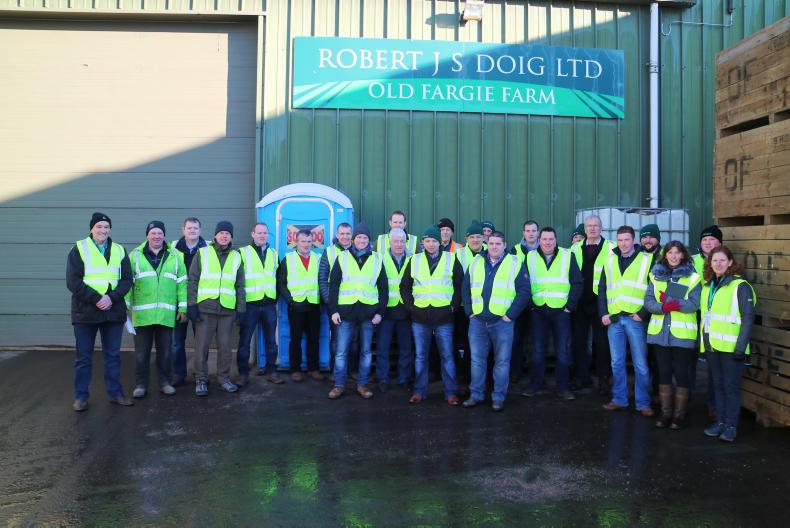
Twenty-two Northern Irish potato growers went on the trip.
The trip was organised by CAFRE (the College of Agriculture, Food and Rural Enterprise) as part of the Farm Innovation Visit scheme (FIVs). FIVs are part of the NI Rural Development Programme and provide funding for groups of farmers to see innovations on farms outside of Northern Ireland. The innovations must be in use on those farms but not yet in use on Northern Irish farms. When the group returns home, they are expected to share what they have learnt with their peers.
The trip was organised in part by potato expert Stuart Wale of the SRUC. The focus of the trip was on visiting stores which used positive ventilation systems. I joined the group over the course of the two-day trip, where we visited five farms located on the eastern side of the country.
Principles of positive ventilation
Ventilation is an important element in storage. Controlling the movement of air through potatoes is the primary means of regulating the crop condition by drying, cooling, heating or humidifying.
Many growers still use ambient air cooling, as the running costs are about a quarter of those of refrigerated cooling.
However, this system limits management capability. Positive ventilation systems use positive pressure to force air through the potato boxes. In modern systems, boxes are stacked against a drying wall which contains a number of openings or envelopes. Most systems tend to suck air. Here, the air is blown over the potato boxes onto the front face of the stack.
The air is sucked through the envelopes in the drying wall into the plenum. In doing so, the air is sucked through the boxes, drying the potatoes. The plenum is a chamber behind the drying wall which holds the air before being drawn back into the fan or refrigerator unit, to be blown over the top of the boxes again.
This positive ventilated system achieves more rapid drying and cooling. It is particularly well suited to densely packed boxes with dirty potatoes and crops that are warm, wet or affected by disease. Box choice is important in positive ventilation systems, and must be in good condition to prevent air leakages.
Positive ventilation systems
One of the most common systems is the letterbox system. Here, boxes are stacked against a drying wall.
The wall contains a number of horizontal openings at distances of two boxes apart. These envelopes lead to the plenum. Boxes are generally stacked six to seven high and eight-deep.
Air is sucked through the envelopes and blown back up over the boxes. Bungs are used to close the gaps between boxes on the face edge at the level of the envelopes. This helps force air through the boxes, as opposed to following the channel under the boxes directly to the envelope. Another popular system used is the aspire system. Here, boxes are stacked around six-high and a cavity is left between the boxes. Tarpaulin then covers the front face and top of the boxes. When air is sucked from the cavity, air is forced through the potato boxes.
Caithness Potatoes
The first farm visit was to Robert Doig’s Caithness Potatoes, based just outside Perth. The family-owned business is involved with breeding, growing and exporting potato seed to customers in Egypt, Morocco, Israel, Norway, Sweden, Italy and the UK. Robert grows around 500ac of seed potatoes. He grows 10 varieties for commercial use, and also grows around 300-400 new varieties in new plots. We explored some of the 10,000 tonne storage capacity on the farm. The first store we visited was capable of using outside air temperature for ambient storage, as well as creating a refrigerate environment.

Willie Officers store could mix ambient and outside air.
This main store used a positive ventilation sucking letterbox system. Boxes are stacked seven-high and the gap between every second box is covered with a bung. Harvest generally begins in September, and the crops are first brought into this store to dry and be cured. Potatoes are cured slowly, before their temperature is pulled down. Everything in the store was automated including temperature control. The temperature of the store at the time of the visit was 2.4°C and the tuber temperature was 3.8°C. When the fan system was running, wind speed through the boxes was 0.7-0.8 m/second.
Greenvale AP
The second visit was to one of the main premises of Greenvale AP, close to Blairgowrie. Greenvale is a major supplier of fresh potatoes in the UK.
Greenvale handle and market around 35,000 tonnes of potato seed per year. Around 25,000 tonnes go to the Irish and UK market, while the rest is exported to north Africa, continental Europe and Middle Eastern countries. Frank J Pairie is responsible for all potato storage on site and he gave us a rundown of the storage facilities.
After trying a number of positive ventilation systems, Frank developed a modified aspire system dubbed the ‘Pairie aspire positive ventilation system’ on the farm.

The Pairie aspire positive ventilation system.
It boasts uniform ventilation of untainted processed air through the boxes. The basic concept involves stacking two rows of boxes against a drying wall which contains a vertical letterbox or opening.
The boxes are stacked six-high and two-wide and a gap is left between each box, to act as a return passage to the letterboxes.
A tarpaulin sheet is then drawn over the vertical front face and the top of each passage. A fan then sucks air from the passage, forcing air to be drawn through the boxes.
Ardoch of Gallery
The final visit of day one was to the farm of Willie Officer at Ardoch of Gallery, near Montrose. The farm covers over 365ac, growing a variety of cereals and around 270ac of potatoes, much of which is seed.

Willie Officer who farms at Ardoch of Gallery near Montrose.
He also grows potatoes on contract, which brings total potato acreage to around 480ac. To diversify the business, a number of years ago they started growing daffodil bulbs and flowers.
Willie availed of grant funding to build a new state of the art dual purpose store, which uses a letterbox sucking ventilation system and is also capable of heating the store.

An example of the envelopes on a letterbox system.
It is suitable for both potato and bulb storage, each of which requires different storage environments. This store can accommodate around 1,700 tonnes and is used around nine months of the year. This store is capable of mixing ambient and outside air but not refrigeration. The store has 90mm insulation, which helps to control the temperatures.
At the time of the visit, the temperature of the store was 3.4°C, with the outside temperature below zero. Boxes are stacked six-high and eight-deep. With eight fans, the store is versatile and suited for multiple uses.
Pluckerston Farms
The first farm of day two saw us visit Northern Ireland’s Peter Lucas and his son Stephen, just north of Dundee. Peter originates from Dungannon, Co Tyrone, but moved to Scotland in 1986.
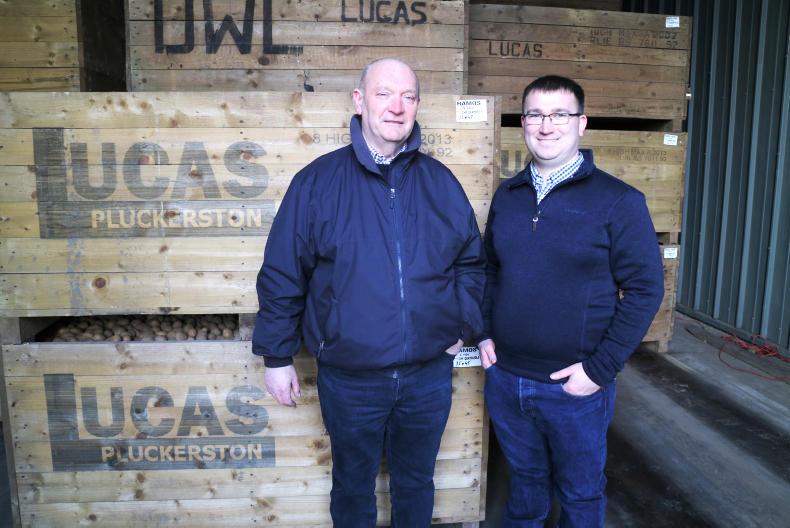
Northern Ireland’s Peter Lucas and his son Stephen.
Since then, he has developed the farm from 80ac in 1995, to growing over 525ac of potatoes in 2018. Peter explains that this was done through the help of a local machinery ring, which helped him gain access to machinery and labour. ‘Ringlink’ is the UK’s largest machinery ring.
Around 80% of his potato production is seed, most of which is grown for export. In 2018, they grew over 54 different varieties. They have cold-storage capacity on farm for around 5,000 tonnes. 2,200t of which is positive ventilated. The store is unique in that it has drying walls at either end. This allows access from both sides of the store, which helps significantly as they are dealing with a high number of varieties. Crops are stored at 2.6°C for ware and 3.5°C for seed. They have a further 2,100 storage capacity off farm.
Hume Farming
The final visit of the trip was to Lindsay Hume, just south of Montrose. Lindsay farms with his sons Jamie and Ross, and covers around 900ac. They grow around 220ac of potatoes, most of which is seed.
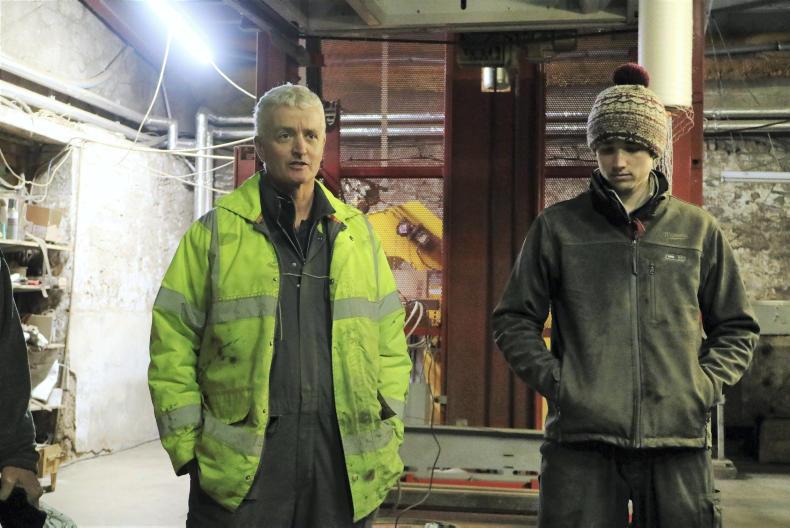
Lindsay Hume with his son Jamie.
The farm has around 5,000 tonne storage capacity and uses the letterbox positive ventilation system. After harvest, the seed crops are brought straight into the positive ventilated store and dried for around 10 days before curing. They generally begin grading and bagging by mid-October. Their export markets include Morocco, Egypt, and the Canaries.
Positive ventilated storage is a system that works particularly well in Scotland and gives growers a lot more control. It is a system that should work well in Ireland too and indeed, many here are already using some kind of positive ventilated storage. On a side note, while not without its challenges, the Scottish seed industry appears to be thriving, with around 300,000 tonnes produced annually.
Much of this is destined for export markets.
Seed potatoes are big business in Scotland and one can’t help wonder where Ireland’s potato seed industry might have been, if the supports had of been there to develop the sector. Just 218ha of seed potatoes were recorded as being grown under the 2018 BPS. Over 8,000 tonnes of seed were imported in the same year.
Read more
New entrant gathering
Seed supply could hamper 2019 EU potato area
Potato storage is an important part of modern potato production. Despite Ireland’s cooler climate, in many cases, refrigerated storage is required in order to maintain market access throughout the year. Whatever storage system used, this represents a significant cost to growers. Therefore, it is important to ensure that a store is as efficient as possible.
This was one of the aims of the recent study trip to Scotland where 22 Northern Irish potato growers saw the latest innovations in potato storage.

Twenty-two Northern Irish potato growers went on the trip.
The trip was organised by CAFRE (the College of Agriculture, Food and Rural Enterprise) as part of the Farm Innovation Visit scheme (FIVs). FIVs are part of the NI Rural Development Programme and provide funding for groups of farmers to see innovations on farms outside of Northern Ireland. The innovations must be in use on those farms but not yet in use on Northern Irish farms. When the group returns home, they are expected to share what they have learnt with their peers.
The trip was organised in part by potato expert Stuart Wale of the SRUC. The focus of the trip was on visiting stores which used positive ventilation systems. I joined the group over the course of the two-day trip, where we visited five farms located on the eastern side of the country.
Principles of positive ventilation
Ventilation is an important element in storage. Controlling the movement of air through potatoes is the primary means of regulating the crop condition by drying, cooling, heating or humidifying.
Many growers still use ambient air cooling, as the running costs are about a quarter of those of refrigerated cooling.
However, this system limits management capability. Positive ventilation systems use positive pressure to force air through the potato boxes. In modern systems, boxes are stacked against a drying wall which contains a number of openings or envelopes. Most systems tend to suck air. Here, the air is blown over the potato boxes onto the front face of the stack.
The air is sucked through the envelopes in the drying wall into the plenum. In doing so, the air is sucked through the boxes, drying the potatoes. The plenum is a chamber behind the drying wall which holds the air before being drawn back into the fan or refrigerator unit, to be blown over the top of the boxes again.
This positive ventilated system achieves more rapid drying and cooling. It is particularly well suited to densely packed boxes with dirty potatoes and crops that are warm, wet or affected by disease. Box choice is important in positive ventilation systems, and must be in good condition to prevent air leakages.
Positive ventilation systems
One of the most common systems is the letterbox system. Here, boxes are stacked against a drying wall.
The wall contains a number of horizontal openings at distances of two boxes apart. These envelopes lead to the plenum. Boxes are generally stacked six to seven high and eight-deep.
Air is sucked through the envelopes and blown back up over the boxes. Bungs are used to close the gaps between boxes on the face edge at the level of the envelopes. This helps force air through the boxes, as opposed to following the channel under the boxes directly to the envelope. Another popular system used is the aspire system. Here, boxes are stacked around six-high and a cavity is left between the boxes. Tarpaulin then covers the front face and top of the boxes. When air is sucked from the cavity, air is forced through the potato boxes.
Caithness Potatoes
The first farm visit was to Robert Doig’s Caithness Potatoes, based just outside Perth. The family-owned business is involved with breeding, growing and exporting potato seed to customers in Egypt, Morocco, Israel, Norway, Sweden, Italy and the UK. Robert grows around 500ac of seed potatoes. He grows 10 varieties for commercial use, and also grows around 300-400 new varieties in new plots. We explored some of the 10,000 tonne storage capacity on the farm. The first store we visited was capable of using outside air temperature for ambient storage, as well as creating a refrigerate environment.

Willie Officers store could mix ambient and outside air.
This main store used a positive ventilation sucking letterbox system. Boxes are stacked seven-high and the gap between every second box is covered with a bung. Harvest generally begins in September, and the crops are first brought into this store to dry and be cured. Potatoes are cured slowly, before their temperature is pulled down. Everything in the store was automated including temperature control. The temperature of the store at the time of the visit was 2.4°C and the tuber temperature was 3.8°C. When the fan system was running, wind speed through the boxes was 0.7-0.8 m/second.
Greenvale AP
The second visit was to one of the main premises of Greenvale AP, close to Blairgowrie. Greenvale is a major supplier of fresh potatoes in the UK.
Greenvale handle and market around 35,000 tonnes of potato seed per year. Around 25,000 tonnes go to the Irish and UK market, while the rest is exported to north Africa, continental Europe and Middle Eastern countries. Frank J Pairie is responsible for all potato storage on site and he gave us a rundown of the storage facilities.
After trying a number of positive ventilation systems, Frank developed a modified aspire system dubbed the ‘Pairie aspire positive ventilation system’ on the farm.

The Pairie aspire positive ventilation system.
It boasts uniform ventilation of untainted processed air through the boxes. The basic concept involves stacking two rows of boxes against a drying wall which contains a vertical letterbox or opening.
The boxes are stacked six-high and two-wide and a gap is left between each box, to act as a return passage to the letterboxes.
A tarpaulin sheet is then drawn over the vertical front face and the top of each passage. A fan then sucks air from the passage, forcing air to be drawn through the boxes.
Ardoch of Gallery
The final visit of day one was to the farm of Willie Officer at Ardoch of Gallery, near Montrose. The farm covers over 365ac, growing a variety of cereals and around 270ac of potatoes, much of which is seed.

Willie Officer who farms at Ardoch of Gallery near Montrose.
He also grows potatoes on contract, which brings total potato acreage to around 480ac. To diversify the business, a number of years ago they started growing daffodil bulbs and flowers.
Willie availed of grant funding to build a new state of the art dual purpose store, which uses a letterbox sucking ventilation system and is also capable of heating the store.

An example of the envelopes on a letterbox system.
It is suitable for both potato and bulb storage, each of which requires different storage environments. This store can accommodate around 1,700 tonnes and is used around nine months of the year. This store is capable of mixing ambient and outside air but not refrigeration. The store has 90mm insulation, which helps to control the temperatures.
At the time of the visit, the temperature of the store was 3.4°C, with the outside temperature below zero. Boxes are stacked six-high and eight-deep. With eight fans, the store is versatile and suited for multiple uses.
Pluckerston Farms
The first farm of day two saw us visit Northern Ireland’s Peter Lucas and his son Stephen, just north of Dundee. Peter originates from Dungannon, Co Tyrone, but moved to Scotland in 1986.

Northern Ireland’s Peter Lucas and his son Stephen.
Since then, he has developed the farm from 80ac in 1995, to growing over 525ac of potatoes in 2018. Peter explains that this was done through the help of a local machinery ring, which helped him gain access to machinery and labour. ‘Ringlink’ is the UK’s largest machinery ring.
Around 80% of his potato production is seed, most of which is grown for export. In 2018, they grew over 54 different varieties. They have cold-storage capacity on farm for around 5,000 tonnes. 2,200t of which is positive ventilated. The store is unique in that it has drying walls at either end. This allows access from both sides of the store, which helps significantly as they are dealing with a high number of varieties. Crops are stored at 2.6°C for ware and 3.5°C for seed. They have a further 2,100 storage capacity off farm.
Hume Farming
The final visit of the trip was to Lindsay Hume, just south of Montrose. Lindsay farms with his sons Jamie and Ross, and covers around 900ac. They grow around 220ac of potatoes, most of which is seed.

Lindsay Hume with his son Jamie.
The farm has around 5,000 tonne storage capacity and uses the letterbox positive ventilation system. After harvest, the seed crops are brought straight into the positive ventilated store and dried for around 10 days before curing. They generally begin grading and bagging by mid-October. Their export markets include Morocco, Egypt, and the Canaries.
Positive ventilated storage is a system that works particularly well in Scotland and gives growers a lot more control. It is a system that should work well in Ireland too and indeed, many here are already using some kind of positive ventilated storage. On a side note, while not without its challenges, the Scottish seed industry appears to be thriving, with around 300,000 tonnes produced annually.
Much of this is destined for export markets.
Seed potatoes are big business in Scotland and one can’t help wonder where Ireland’s potato seed industry might have been, if the supports had of been there to develop the sector. Just 218ha of seed potatoes were recorded as being grown under the 2018 BPS. Over 8,000 tonnes of seed were imported in the same year.
Read more
New entrant gathering
Seed supply could hamper 2019 EU potato area











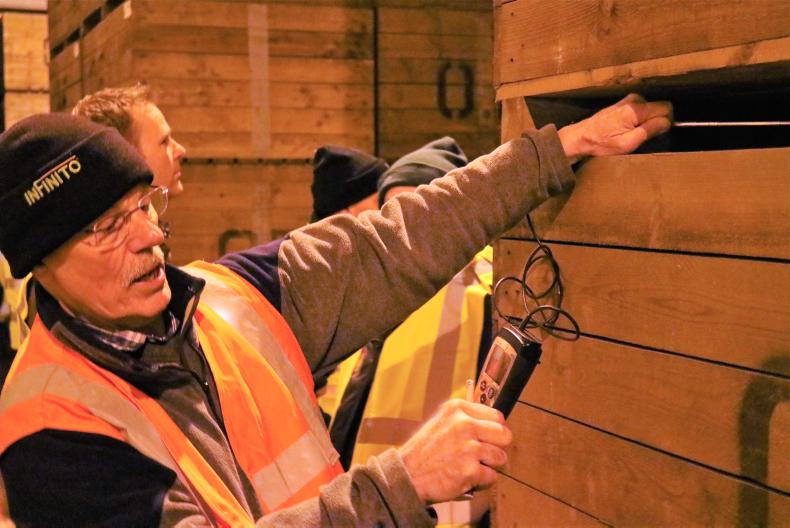
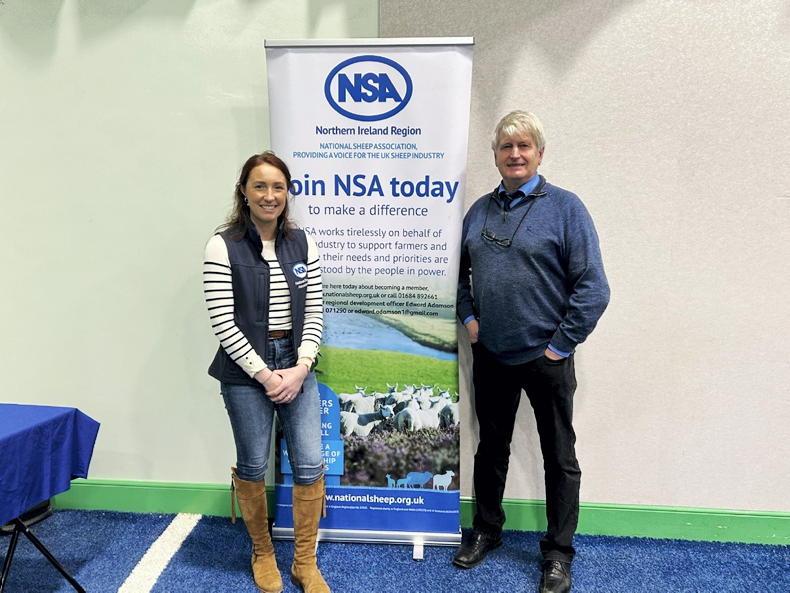

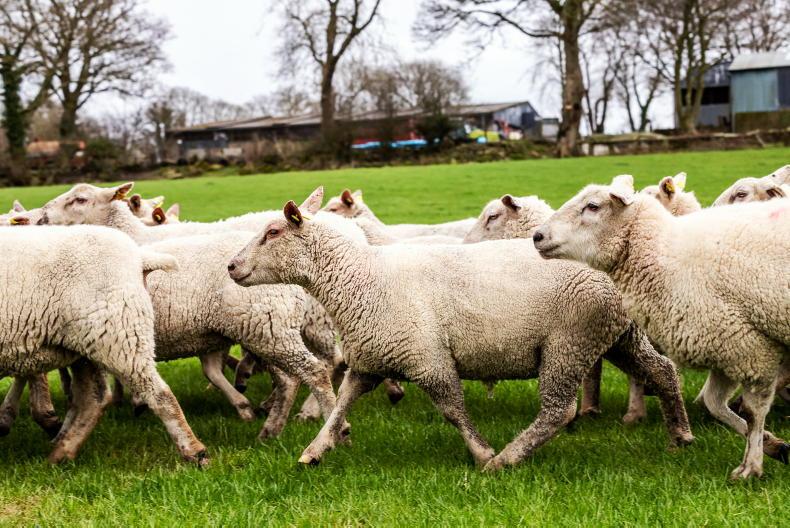
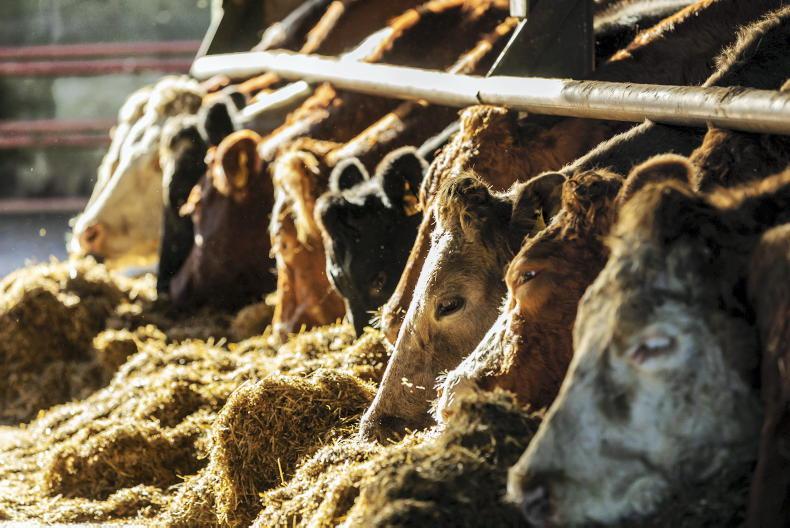
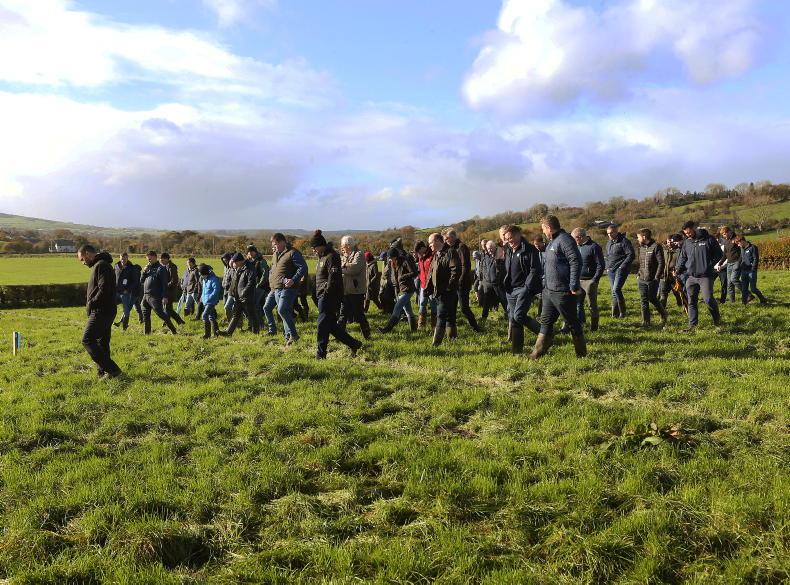
SHARING OPTIONS